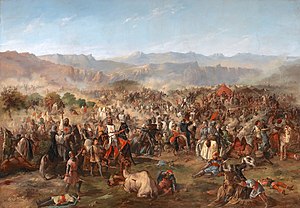
Back Batalla de Las Landas de Tolosa AN معركة العقاب Arabic معركة لاس ناڤاس دى تولوسا ARZ Batalla de Las Navas de Tolosa AST Las Navas de Tolosa döyüşü Azerbaijani ناواس دتلوسا دؤیوشو AZB Битка при Лас Навас де Толоса Bulgarian Emgann Las Navas de Tolosa Breton Batalla de Las Navas de Tolosa Catalan Bitva na Las Navas de Tolosa Czech
| Battle of Las Navas de Tolosa | |||||||
|---|---|---|---|---|---|---|---|
| Part of the Reconquista (Spanish Christian–Muslim War of 1172–1212) | |||||||
 Portrayal of the battle by Francisco de Paula Van Halen (1864) | |||||||
| |||||||
| Belligerents | |||||||
|
Volunteers from the Kingdom of Leon and the Kingdom of Portugal Crusaders from all over Europe | Almohad Caliphate | ||||||
| Commanders and leaders | |||||||
Vanguard: Right wing: Left wing: | Muhammad al-Nasir | ||||||
| Strength | |||||||
| 12,000–14,000[7][8] |
22,000–30,000[7][9] "Many hundreds of thousands"[10] | ||||||
| Casualties and losses | |||||||
| ~2,000[11][page needed] | ~20,000[8] | ||||||
The Battle of Las Navas de Tolosa, known in Islamic history as the Battle of Al-Uqab (Arabic: معركة العقاب), took place on 16 July 1212 and was an important turning point in the Reconquista and the medieval history of Spain.[13] The Christian forces of King Alfonso VIII of Castile, were joined by the armies of his rivals, Sancho VII of Navarre and Peter II of Aragon, in battle[14] against the Almohad Muslim rulers of the southern half of the Iberian Peninsula. The caliph al-Nasir (Miramamolín in the Spanish chronicles) led the Almohad army, made up of people from all over the Almohad Caliphate.
- ^ Smith 1989, p. 14.
- ^ Gitlitz & Davidson 2000, p. 60.
- ^ Crusade and Christendom: Annotated Documents in Translation from Innocent III to the Fall of Acre, 1187-1291. United States: University of Pennsylvania Press, Incorporated, 2013, p.80
- ^ Villalon, Andrew., Kagay, Donald. To Win and Lose a Medieval Battle: Nájera (April 3, 1367), A Pyrrhic Victory for the Black Prince. Netherlands: Brill, 2017, p.40
- ^ McNab, Chris. Famous Battles of the Medieval Period. United States: Cavendish Square Publishing LLC, 2017, p.46
- ^ Setton 1975, p. 423.
- ^ a b c Cabrer 2012, p. 332.
- ^ a b Nutter 2023.
- ^ Cabrer 2000, p. 196.
- ^ ,Notes On Entering Deen Completely: Islam as its followers know it. N.p.: EDC Foundation, 2015, p. 619[1]
- ^ Gomez 2011.
- ^ Nafziger & Walton 2003, p. 87.
- ^ Hunt et al. 2007, p. 391.
- ^ Guggenberger 1913, p. 372.